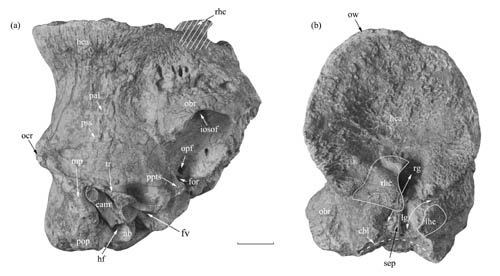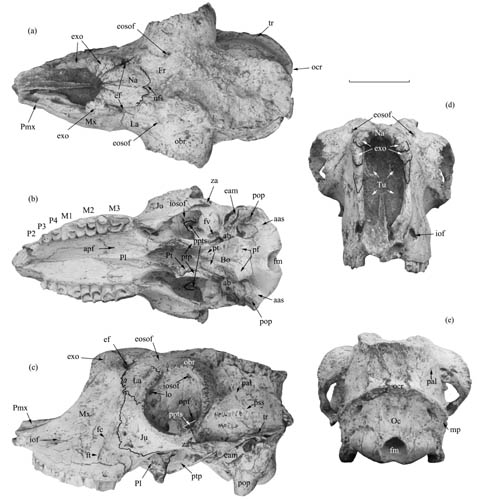| Location: Home > Research > Research Progress |
| Bizarre Bovid Species Found from the Late Miocene of Linxia Basin, China |
|
Numerous Neogene mammal fossils have been excavated in Hezheng area, Gansu province since the 1970s. Two fossil skulls of a bizarre bovid were discovered in recent years. In an article published in the journal of Science China (Earth Sciences) 57 (2), Dr. SHI Qinqin, Institute of Vertebrate Paleontology and Paleoanthropology (IVPP), Chinese Academy of Sciences, described them as a new species, Tsaidamotherium brevirostrum. This is the second discovery of the genus in Northwest China nearly 70 years after the genus was initially established, sheding new light on the skull morphology and systematics of the genus. Tsaidamotherium is a mid-sized late Miocene bovid with an odd-looking horn-core apparatus so far known only from northwestern China. During the Sino-Swedish Scientific Expedition to Northwest China in the early 1930s, two bovid cranial parts with odd-looking horn-core apparatus were collected from the Miocene deposits in the Qaidam Basin. The "completely unique horn-core apparatus" of the cranial parts seemed so peculiar and important that these cranial parts were assigned to a new genus and species in 1935, Tsaidamotherium hedini. Since then not even a single specimen of Tsaidamotherium has been reported. The holotype of Tsaidamotherium brevirostrum is a cranial part of skull with well-preserved horn-core apparatus, basioccipital and occipital regions. It was collected from the Liushu Formation (late Miocene) of the Linxia Basin near the village Yancanping, approximately 2.5 km east of Maijiaji Township. Of the new specimens there is also a nearly complete skull of female individual, with the top part of its horn-core apparatus damaged. The new species differs from the type species, T. bohlini, mainly in horn-core morphology, having the frontal horn-cores proper much smaller and less distinctly separated from the plate-shaped posterior portion. Furthermore, the new species has smaller frontal sinuses, but a thicker layer of compact bone beneath the horn-core apparatus as seen in frontal section. A complete skull with a smaller horn-core apparatus is considered to represent a female individual of T. brevirostrum. The facial part of the skull, which is first known for this genus, is very short and high, with a high nasal cavity, strongly retracted nasals, and shortened premaxillae and premolar rows. All this probably suggests that the animal with an enlarged nasal cavity, like the modern Saiga and Budorcas, may have had a special adaptation to the high plateau environment. Although the fossil material of Tsaidamotherium is extremely scarce, its distribution area might be a long strip along the north margin of the Tibetan plateau, since the localities of the two species are almost 600 km apart from each other. The distribution of this kind of animal may even extend to Xinjiang Uygur Autonomous Region. To date, Tsaidamotherium is found only in Northwest China, and seems to be a highly endemic form there. This work was supported by Strategic Priority Program of the Chinese Academy of Sciences, National Basic Research Program of China, and National Natural Science Foundation of China.  Fig.1 Holotype skull of Tsaidamotherium brevirostrum sp. nov. (Image by SHI Qinqin)  Fig.2 Skull of female individual of Tsaidamotherium brevirostrum sp. nov. (Image by SHI Qinqin)  Fig.3 Skull reconstruction of Tsaidamotherium brevirostrum sp. nov. (Image by SHI Qinqin) |